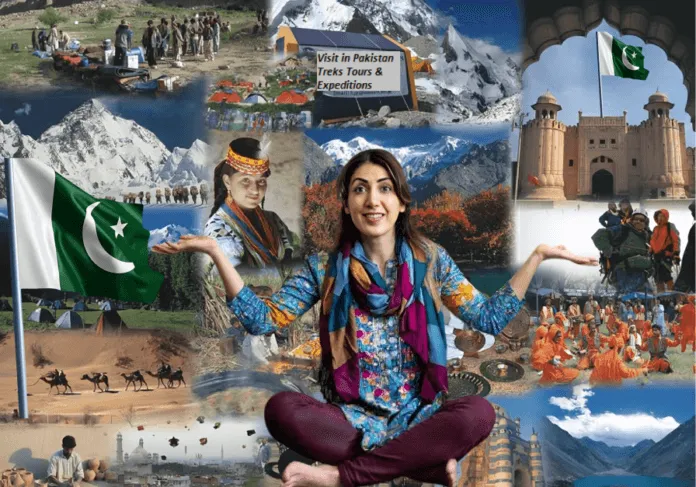Traveling to Pakistan is a journey filled with surprises, offering a rich tapestry of scenic beauty, cultural heritage, and warm hospitality. Known for its incredible diversity in landscapes—from towering mountain glaciers to the serene waters of the Indus River—Pakistan is home to some of the most breathtaking forts, mosques, and archaeological sites in the Subcontinent. For those planning on travelling to Pakistan, the country serves as a cultural bridge between India and Central Asia, with a history and hospitality that rival any global destination.
Exploring Pakistan’s Diverse Landscape
One of the most compelling reasons for travelling to Pakistan is the unmatched variety of scenery. From the towering peaks of the Karakoram and Himalayas to the rolling plains of Punjab and the deserts of Sindh, Pakistan offers something for every traveler.
The Hunza Valley, Fairy Meadows, and Skardu are just a few of the northern gems that captivate visitors. Those interested in history can explore ancient forts like Lahore Fort or the majestic Badshahi Mosque, remnants of the country’s Islamic and Mughal heritage.
For those venturing south, the sprawling coastline along the Arabian Sea, including the famous Clifton Beach in Karachi, contrasts beautifully with the mountainous north. The country’s cultural and natural beauty has made travelling to Pakistan an increasingly attractive option for adventure seekers and history enthusiasts alike.
Navigating Pakistan’s Mixed Reputation
While Pakistan has garnered some negative attention internationally due to economic and political challenges, the security situation has improved significantly in recent years. Travelling to Pakistan may require some planning, but the welcoming nature of its people is guaranteed to leave a lasting impression. However, research and preparation are essential to ensure a safe and enjoyable experience. It’s crucial to stay updated on the latest travel advisories and plan accordingly.
Best Time for Travelling to Pakistan: Choose Your Season Wisely
The ideal time for travelling to Pakistan varies depending on the region you wish to explore. If you’re headed for the mountainous north, the summer months (July and August) are perfect for trekking and sightseeing. However, this is also peak tourist season for domestic travelers. For those looking to explore central and southern Pakistan, the cooler months of spring (April-May) and autumn (October-November) provide the best weather for sightseeing, without the crowds or extreme heat. The Hunza Valley, in particular, comes alive with vibrant autumn colors in October, offering a breathtaking view of nature’s transformation.
Essential Visa and Travel Documents
Most visitors need a visa to enter Pakistan, and applying through the e-visa system can sometimes be challenging. Along with the visa, you’ll need a letter of invitation, usually arranged through a local travel agent, hotel, or host. Make sure you prepare these documents well in advance to avoid delays or last-minute complications.
Cultural Etiquette: Hospitality and Respect
One of the highlights of travelling to Pakistan is experiencing the unmatched hospitality of its people. It’s common for locals to invite travelers for tea or even meals, and many will go out of their way to make you feel welcome. While accepting invitations is a great way to immerse yourself in the local culture, it’s important to be mindful of the customs and avoid overburdening your hosts.
In addition, Pakistan’s conservative culture means that travelers, particularly women, should dress modestly and be aware of local customs. For instance, public displays of affection are frowned upon, and visitors are advised to dress conservatively when visiting religious or rural areas.
Practical Tips: SIM Cards, Transport, and Documents
To ensure you stay connected while travelling to Pakistan, purchasing a local SIM card is highly recommended. This will help you navigate the country and use local transport apps like Uber or Careem, especially in larger cities such as Islamabad, Lahore, and Karachi. Additionally, keep photocopies of your passport and visa handy, as they will be required at numerous checkpoints, particularly during long-distance road trips.
Female Travelers: Unique Challenges and Rewards
While travelling to Pakistan, women may face certain challenges due to the country’s conservative nature. Public spaces are often gender-segregated, and female travelers may encounter curiosity or protective attitudes from locals. That being said, the rewards of traveling as a woman in Pakistan include the opportunity to engage with local women, offering an authentic insight into the country’s unique social dynamics.
Dress Like a Local: Invest in a Shalwar Kameez
For an authentic experience while travelling to Pakistan, consider purchasing a traditional shalwar kameez—the national dress that’s comfortable, practical, and helps you blend in. Women should also carry a dupatta (scarf) to cover their heads when visiting mosques or religious sites.
Bargaining and Shopping
When shopping in local markets, bargaining is an essential skill. Travelling to Pakistan offers opportunities to buy unique handicrafts, textiles, and souvenirs, but remember to approach haggling as a light-hearted exchange. Building rapport with sellers and negotiating respectfully will ensure both parties walk away satisfied.
Be Aware of Restricted Areas
Certain areas in Pakistan, such as parts of Baluchistan and Khyber Pakhtunkhwa, require special permission for foreign visitors due to security concerns. It’s essential to stay informed about any travel restrictions or no-go zones and always follow local advice to ensure your safety.
Also Read: Punjab Launched Luxurious “Glamping Pods” to Boost Tourism


